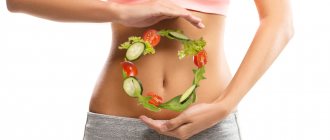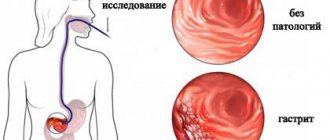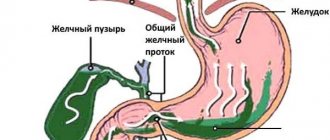Almost every person has encountered a situation where their stomach hurts after eating.
This is not always given due importance, taking any “stomach” pills, folk remedies, or ignoring contact with a doctor. However, pain that appears in the stomach after eating is not always random and transient; it can have serious causes that require examination and treatment. Therefore, it is necessary to know their possible causes, and what to do in each specific case - use home remedies, or seek medical help.
Causes of pain after eating
The stomach is a very sensitive organ, equipped with a huge number of nerve endings, and it reacts to adverse effects with a defensive reaction - pain, as if sending its “owner” a signal of trouble. This can be the result of various abuses and diseases of the digestive system.
On the other hand, the stomach is connected by nerve plexuses to other internal organs, and the pathological process in them can manifest itself as pain in the stomach both after and regardless of food. Therefore, all causes of stomach pain can be divided into groups:
- directly related to stomach diseases;
- related to eating errors;
- associated with diseases of other organs.
Pain after eating due to stomach problems
The most common stomach disease is gastritis, which affects more than half of the population, and the most characteristic symptom of it is pain in the epigastric (epigastric) region. During the period of remission, they can appear after errors in the diet, and during the period of exacerbation - after any meal.
Second place goes to stomach ulcer , it is always accompanied by pain when the diet is not followed, and in the acute phase it is quite intense, manifesting itself even in response to dietary products.
Acute food poisoning is also always accompanied by pain in the stomach, because acute bacterial gastroenteritis develops - the mucous membrane swells and becomes inflamed, and it reacts painfully to contact with food.
Diseases of other digestive organs - the esophagus ( esophagitis , tumors), pancreatitis, cholecystitis, hepatitis are very often accompanied by pain in the left hypochondrium, in the epigastric region; they arise as a result of visceral-visceral (interorgan) reflexes.
Pain after eating errors
Why do healthy people experience stomach pain after eating? There is only one reason – gross nutritional disorders. Most often this happens after heavy feasts, when too much protein and fatty foods and sweet dishes are eaten. The functional abilities of the gastric glands are limited, its enzymes cannot digest excess food, and it becomes an irritant to the mucous membrane, causing pain. Spicy seasonings and alcohol have a similar effect on the stomach.
If such “attacks” are only episodic, then the mucous membrane is completely restored. Systematic libations and overeating inevitably lead to the development of gastritis and peptic ulcers.
Other diseases that cause stomach pain
The appearance of pain in the stomach after eating can be caused by other reasons not related to digestive diseases or diet errors, these include:
- heart disease;
- lung diseases;
- spine pathology;
- pregnancy period.
Heart diseases
Attacks of angina often radiate to the left hypochondrium; this happens when the area of oxygen starvation of the myocardium is located closer to the apex of the heart. There is also a clinical form of heart attack - gastric, which is manifested by abdominal pain, vomiting, and often simulates food poisoning.
Lung diseases
Left-sided pneumonia and pleurisy are accompanied by pain, which often radiates to the left hypochondrium, simulating stomach pain. In addition, they are characterized by cough, shortness of breath, and fever.
Spinal diseases
Any pathology in the spine - osteochondrosis, spondylosis, tumors and injuries that cause compression of the lower thoracic roots on the left, can create the impression of pain in the stomach. They are characterized by a sharp increase in pain when bending and turning the body.
Pregnancy
In the second half of pregnancy, especially in the last trimester, due to the enlargement of the uterus, the small intestine is compressed and displaced upward, and it puts pressure on the stomach, reducing its volume. Therefore, even with normal nutrition, pain may appear. An important role is played by changes in hormonal levels, which negatively affect the mucous membrane, causing swelling and inflammation.
Diagnostics
To find out the causes of stomach pain after eating, gastroenterologists prescribe laboratory and instrumental examinations to their patients. However, before carrying them out, the clinician needs to independently carry out several manipulations, namely:
- clarify the patient’s complaints - to identify the presence of additional symptoms and determine the degree of intensity of manifestation of the main symptom;
- get acquainted with the medical history and life history of the patient - may indicate an etiological factor;
- conduct an objective examination with mandatory palpation of the abdomen.
Among the laboratory examinations it is worth highlighting:
- clinical blood test - to detect possible anemia and inflammatory changes;
- biochemical blood test - to monitor the functioning of the gastrointestinal tract and identify signs of a particular disease;
- general urine analysis;
- coprogram.
Instrumental examinations include:
- Ultrasound of the abdominal cavity;
- FEGDS - study of the inner surface of the esophagus, stomach and the initial part of the duodenum using a probe with a camera;
- radiography;
- biopsy – in cases of suspected oncological process;
- CT and MRI.
Stomach biopsy
Clinical manifestations
Types and nature of pain
The nature of the pain that occurs after eating in the stomach area can be different. They can be sharp, appear suddenly, and sometimes have a “dagger” character, as if the stomach was pierced with a knife. Such signs indicate an acute pathology requiring emergency care. This happens when the mucous membrane ruptures, perforation of the stomach wall due to an ulcer.
Cramping pain is characteristic of pylorospasm in peptic ulcers, as well as acute gastroenteritis in food poisoning; they are caused by spasms in the stomach and intestines.
More often, the pain is dull, aching in nature - it arises, gradually increases, and also decreases after the cause is eliminated. This is how chronic diseases of the digestive system usually manifest themselves during malnutrition, during periods of exacerbation.
What does the localization of pain and the timing of its onset indicate?
Two factors of stomach pain are of great diagnostic importance:
- localization;
- time of appearance, depending on food intake.
Localization
The location of the pain is determined by the anatomy of the stomach. Most of it (bottom and body) is located in the epigastrium on the left, the antrum is closer to the midline, and the pyloric (outlet) section is in the right hypochondrium behind the liver. This determines the localization of pain.
In the epigastrium on the left, pain occurs due to pathology in the cardiac part of the stomach, bordering the esophagus, in the area of the fundus and lesser curvature. Pathology located in the central part of the body, the greater curvature is characterized by pain in the center of the epigastrium. The pyloric region, where the ulcerative process often occurs, gives pain in the right epigastric region, which may resemble cholecystitis.
This pattern is only an ideal option, but there are deviations both in the anatomy and in the nature of the pathology, and only a doctor can evaluate them.
Time of onset of pain
When the appearance of pain is associated with eating, this indicates its gastric origin:
- pain immediately after eating is characteristic of acute and chronic gastritis;
- pain that appears half an hour after eating is a symptom of a peptic ulcer with a defect in the fundus and body of the stomach;
- “Hungry” pain 5-6 hours after eating is characteristic of pyloric and duodenal ulcers.
Additional symptoms
Other symptoms accompanying stomach pain include a feeling of heaviness in the stomach, a feeling of heartburn, and when the contents in the stomach stagnate, nausea and belching appear. With the development of acute gastroenteritis as a result of food poisoning, the characteristic symptoms are vomiting and diarrhea.
Self-diagnosis for stomach pain after eating
How to assess your condition if your stomach hurts after eating? If there is already any disease of the digestive system, then every patient knows why pain occurs and what to do in such cases. And if pain occurs for the first time, you need to analyze your diet to see if there were any errors or abuses in it.
Aching moderate pain without vomiting, diarrhea, fever and without disruption of the general condition does not require immediate medical attention, but it is necessary to visit a doctor in the coming days.
When should you see a doctor immediately?
In medicine there is the concept of “acute abdomen”, it includes:
- intense pain, cramping in the abdomen;
- nausea, vomiting;
- abdominal muscle tension;
- violation of general condition;
- temperature increase.
Not all of these symptoms are always pronounced; the main one is severe pain, and this is an indication to call the emergency room.
Gallstones
Gallstones can lie in the gallbladder for years, and a person will have no idea that he has them. But one terrible day they will move and stand in the bile duct. Then the patient will feel a sharp, sudden pain in the abdominal cavity. In addition to this, there is also nausea, a feeling of bitterness in the mouth, and vomiting.
The treatment strategy for gallstone disease will depend on the severity of the patient's condition. Surgery is resorted to when the stones are too large or insoluble in composition. Cholesterol stones are classified as soluble. If they are less than 2 cm in diameter, they dissolve well with the help of drugs with ursodeoxycholic acid (ursosan). If there are more stones, then the gallstones need to be removed. As in the case of bilirubin stones, you should not even try to remove them with medication.
Help with stomach pain after eating
Self help
When pain occurs after eating in patients suffering from gastritis, peptic ulcers, or pancreatitis, they, as a rule, have a home first aid kit recommended by a doctor for such cases. If pain appears for the first time, nothing should be done without a doctor’s examination. You need to refrain from eating, take small portions of slightly warmed (up to 40-45°C) still mineral water and consult a doctor.
Under no circumstances should you treat pain with drugs without finding out the cause of the pain. Analgesics can erase the clinical picture and interfere with the doctor’s diagnosis.
Health care
After examination, examination and diagnosis, the doctor selects medications. These can be antiulcer drugs - antacids , gastroprotectors , mucosal regeneration agents, vitamins. If Helicobacter and other pathogenic microbes are detected, antibiotics are prescribed. A prerequisite for successful treatment is diet therapy.
Diet
The basic principles of the diet are to eat sparing and at the same time nutritious food. It is necessary to completely exclude from the diet spicy, fried foods, animal fats, raw vegetables and fruits, alcoholic and carbonated drinks, canned food, smoked foods, marinades, and limit the consumption of sweets.
Food should be warm, steamed or boiled. The diet should include a sufficient amount of easily digestible protein, vegetable oils, dairy products, stewed vegetables, baked fruits, fruit and berry jelly. The diet is very important: food should be taken in small portions 4-6 times a day, at strictly defined hours.
Thyroid problems
With hyperthyroidism - hyperfunction of the thyroid gland - patients may experience disorders of the digestive system, namely abdominal pain. Patients also complain of increased sweating, muscle weakness, weight loss, anxiety, rapid heartbeat, and surges in blood pressure. In women, the menstrual cycle may be disrupted, and in men, potency may decrease. If you have these symptoms, first make an appointment with your therapist. Take a general blood test and find out whether the reason is hormones or something else
https://youtu.be/LxBBAO0Qxgc
Useful video
Doctors tell you how not to harm the digestion process in this video.
Folk remedies
To calm pain and cramps in the stomach, traditional medicine recommends herbal remedies, here are a few examples:
- calamus root, birch buds, aloe leaf - 1 tablespoon each, brew 0.5 liters of water in a thermos, leave for 1 hour, take 50 ml on an empty stomach 2-3 times a day;
- calendula flowers, chamomile, dill seeds, rose hips - mix in equal parts, 1 tablespoon of the collection is brewed with 0.5 liters of boiling water, kept in a water bath for half an hour, take 100 ml half an hour before meals;
- St. John's wort, immortelle, yarrow, oak bark - mixed in equal volumes, preparation and administration are the same as in previous collections.
This is not a complete list of folk remedies; juice of fresh cabbage, sea buckthorn berries, aloe and other remedies are used. You just need to remember that you cannot abuse them and use them blindly. Their choice depends on the acidity of gastric juice and should be agreed with a doctor.
Prevention
Preventing pain after eating essentially comes down to normalizing lifestyle and nutrition. Overeating, dry snacking, eating rough and spicy food should be avoided, and it should not be too hot or cold. It is very important to establish a diet; the stomach should not be empty or overloaded for a long time.
Alcohol consumption should be reduced to a minimum, and people with chronic digestive diseases should completely avoid it. It is also important to devote time to physical exercise, especially for those people who work in offices and do not move much.











